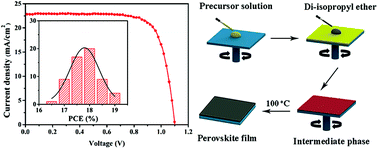Our official English website, www.x-mol.net, welcomes your feedback! (Note: you will need to create a separate account there.)
Di-isopropyl ether assisted crystallization of organic–inorganic perovskites for efficient and reproducible perovskite solar cells
Nanoscale ( IF 6.7 ) Pub Date : 2017-10-25 00:00:00 , DOI: 10.1039/c7nr06410a Lu-Yao Wang 1, 2, 3, 4 , Lin-Long Deng 1, 2, 3, 4 , Xin Wang 1, 2, 3, 4 , Tan Wang 2, 5, 6, 7, 8 , Hao-Ran Liu 1, 2, 3, 4 , Si-Min Dai 2, 5, 6, 7, 8 , Zhou Xing 2, 5, 6, 7, 8 , Su-Yuan Xie 2, 5, 6, 7, 8 , Rong-Bin Huang 2, 5, 6, 7, 8 , Lan-Sun Zheng 2, 5, 6, 7, 8
Nanoscale ( IF 6.7 ) Pub Date : 2017-10-25 00:00:00 , DOI: 10.1039/c7nr06410a Lu-Yao Wang 1, 2, 3, 4 , Lin-Long Deng 1, 2, 3, 4 , Xin Wang 1, 2, 3, 4 , Tan Wang 2, 5, 6, 7, 8 , Hao-Ran Liu 1, 2, 3, 4 , Si-Min Dai 2, 5, 6, 7, 8 , Zhou Xing 2, 5, 6, 7, 8 , Su-Yuan Xie 2, 5, 6, 7, 8 , Rong-Bin Huang 2, 5, 6, 7, 8 , Lan-Sun Zheng 2, 5, 6, 7, 8
Affiliation

|
Organic–inorganic perovskite solar cells have emerged as a promising photovoltaic technology because of their advantages such as low cost, high efficiency, and solution processability. The performance of perovskite solar cells is highly dependent on the crystallinity and morphology of the perovskite films. Herein, we report a simple, one-step anti-solvent deposition process using di-isopropyl ether as a dripping solvent to obtain extremely uniform and highly crystalline CH3NH3PbI3 perovskite films. Compared to toluene, chlorobenzene, chloroform, or diethyl ether, di-isopropyl ether has proven to be a more suitable solvent for an anti-solvent deposition process. The perovskite solar cells fabricated by the anti-solvent deposition process using di-isopropyl ether treatment exhibit an average power conversion efficiency (PCE) of 17.67 ± 0.54% and the highest PCE of 19.07%. Moreover, the higher boiling point of di-isopropyl ether makes the anti-solvent deposition process more tolerant to elevated ambient temperature, which can be carried out at ambient temperatures up to 40 °C. Our results demonstrate that di-isopropyl ether is an excellent dripping solvent in the anti-solvent deposition process for efficient and reproducible perovskite solar cells.
中文翻译:

二异丙醚辅助有机-无机钙钛矿的结晶,可实现高效且可复制的钙钛矿太阳能电池
有机-无机钙钛矿太阳能电池因其低成本,高效率和溶液可加工性等优点而成为一种有前途的光伏技术。钙钛矿太阳能电池的性能高度依赖于钙钛矿薄膜的结晶度和形态。本文中,我们报告了一种简单的一步式反溶剂沉积工艺,该工艺使用二异丙醚作为滴加溶剂,以获得非常均匀且高度结晶的CH 3 NH 3 PbI 3。钙钛矿膜。与甲苯,氯苯,氯仿或二乙醚相比,二异丙醚已被证明是用于反溶剂沉积工艺的更合适的溶剂。通过使用二异丙醚处理的反溶剂沉积工艺制造的钙钛矿太阳能电池表现出17.67±0.54%的平均功率转换效率(PCE)和19.07%的最高PCE。此外,较高的二异丙醚沸点使抗溶剂沉积工艺对升高的环境温度具有更高的耐受力,该温度可以在最高40°C的环境温度下进行。我们的结果表明,二异丙醚在高效和可重复生产的钙钛矿太阳能电池的反溶剂沉积工艺中是一种出色的滴落溶剂。
更新日期:2017-11-23
中文翻译:

二异丙醚辅助有机-无机钙钛矿的结晶,可实现高效且可复制的钙钛矿太阳能电池
有机-无机钙钛矿太阳能电池因其低成本,高效率和溶液可加工性等优点而成为一种有前途的光伏技术。钙钛矿太阳能电池的性能高度依赖于钙钛矿薄膜的结晶度和形态。本文中,我们报告了一种简单的一步式反溶剂沉积工艺,该工艺使用二异丙醚作为滴加溶剂,以获得非常均匀且高度结晶的CH 3 NH 3 PbI 3。钙钛矿膜。与甲苯,氯苯,氯仿或二乙醚相比,二异丙醚已被证明是用于反溶剂沉积工艺的更合适的溶剂。通过使用二异丙醚处理的反溶剂沉积工艺制造的钙钛矿太阳能电池表现出17.67±0.54%的平均功率转换效率(PCE)和19.07%的最高PCE。此外,较高的二异丙醚沸点使抗溶剂沉积工艺对升高的环境温度具有更高的耐受力,该温度可以在最高40°C的环境温度下进行。我们的结果表明,二异丙醚在高效和可重复生产的钙钛矿太阳能电池的反溶剂沉积工艺中是一种出色的滴落溶剂。


























 京公网安备 11010802027423号
京公网安备 11010802027423号